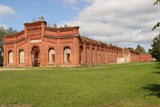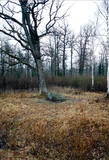| Нo | Название | Описание |
|---|---|---|
|
Zemnieku saimniecība "Mežnoras" Raunā izveidota 1993.gadā. Saimnieki Aivars, Ārija un Līga Urbasti šobrīd audzē 1,6 ha vasaras un rudens avenes, arī nelielās platībās zemenes uz lauka un segtās platībās, siltumnīcā. Zemenes no "Mežnorām" parasti pieejamas laikā no maija vidus līdz oktobra vidum. "Mežnorās " audzē vasaras avenes "Norna", rudens avenes "Babje ļeto", “Polana”, populāro zemeņu šķirni “Polka”. No savā dārzā audzētajām ogām (upenes, jāņogas, ķirši, zemenes u.c.) Aivars gatavo mājas vīnu: "Mežnoru vīns pilnībā sākās Mežnorās. Tas piedzimst nevis mucās, bet sākas mūsu zemeņu vai aveņu laukā, un tās ir daudz dziļākas saknes, kas atstāj pēdas arī garšā”. Saimniecībā audzētais pieejams uz vietas Raunā, gan arī Straupes Lauku labumu tirdziņā, Straupes Hanzas tirgū, arī sezonā - Cēsu tirgū. |
||
|
В третью субботу каждого месяца с 9:00 до 13:00 в Гулбене проходит Зеленый базарчик, где собираются надомники, ремесленники и крестьяне из разных краев Латвии. Предлагают лакомства домашнего производства, сезонные овощи и фрукты, а также предметы красоты и дизайна и другие полезные в быту и необходимые для украшения быта вещи. |
||
|
Tūrisma gide Ineta Jansone piedāvā ekskursijas grupām gar Kaņiera ezeru, iepazīstinot ar putniem, kuri mīt tā tuvumā. Kaņiera ezers ir vieta, kur migrācijas laikā apmetas daudzi tūkstoši ūdensputnu. Ezerā un tā apkārtnē sastopamas vairāk nekā 200 putnu sugu. Putnu vērotāju ērtībām vienā no Kaņiera ezera pussalām uzcelts putnu vērošanas tornis. Netālu no putnu vērošanas torņa izveidota koka laipa uz pontoniem, kura stiepjas cauri niedrāju audzei. Kaņiera ezers izceļas ar lielu daudzums zivju – tajā konstatētas gandrīz 20 zivju sugu. Izsens zvejnieku ciems - Lapmežciems atrodas skaistā vietā uz šauras zemes strēles starp Kaņiera ezeru un Rīgas jūras līci. Lapmežciemā izveidots zvejnieku muzejs, kuru var apmeklēt ekskursijas laikā, kā arī nobaudīt svaigi kūpinātas zivis. |
||
|
Уникальный тематический парк на первозданном берегу реки Пирита создан с целью вызвать интерес к могуществу древних викингов. Возможности: крепость викингов, место комланий, кузница, древние единоборства, представления, поездка за сокровищами по реке Пирита на судне викингов, путешествие на лодке-долбленке, камнеметательная машина, стрельба из лука, метание топора, баня-землянка и баня по-черному, ловля форели, приключенческое проживание, питание и т. д. |
||
|
Ремесленницы из глины делают посуду, вазы, подсвечники, фонари, садовую керамику и изделия мелкой пластики. Интересно, что есть глиняная посуда с деревянными ручками. Предлагают экскурсию, наблюдение за работой гончара, возможность самому присесть к гончарному кругу, а также приобрести уже готовую продукцию. |
||
|
Ресторан «Марияс кафия» находится в центре города Резекне рядом с университетом, в здании со сводчатыми погребами. Латышская кухня: Холодный суп, тонкие и картофельные блины, свиное жаркое, свиные ребрышки, котлеты из телятины, тушеная баранина, жареная треска или форель. Особое блюдо: Салат из козьего сыра. |
||
|
SIA “North Latgallian Firewood” darbības pamatnozare ir mežsaimniecība un kokmateriālu sagatavošana - uzņēmumā nodarbojas ar malkas sagatavošanu un tirdzniecību, kā arī piedāvā malkas gabalošanu un skaldīšanu izbraukumā pie klienta. Uzņēmuma piedāvātie pakalpojumi – malkas sagatavošana, malkas tirdzniecība lielos apjomos, kokmateriālu sagatavošanas pakalpojumi. Brīvajā laikā uzņēmuma īpašnieks restaurē senus motociklus un ir izveidojis plašu retro motociklu un senlietu kolekciju. |
||
|
Здесь ждут в гости как группы, так и индивидуальных посетителей. Хозяева предлагают насладиться баней по-черному, пообедать и попробовать испеченного по древним рецептам суйтского хлеба, пирогов и особого печенья с семечками. |
||
|
На востоке от дороги Эзермуйжи - Думеле находится древнее русло (балка) Диевиньэзера. Это было одно из самых больших озер в Курземе - длиной 7,5 км и шириной 1,6 км. В 1838 году был вырыт канал - теперяшняя Мелнсилупе - и озерную воду спустили в море, чтобы получить плодородную почву для сельского хозяйства. Жители Эзермуйжи еще со времен баронов были связаны с лесным хозяйством и лесозаготовками. Думеле с Кошрагсом связывает одинокая лесная дорога - т.н. Нижняя дорога - по которой проходит велосипедный маршрут. В Думеле расположен коттедж для отдыха «Зиедкални». |
||
|
This tour of the Forest Trail covers the national parks of Dzūkija and Žemaitija and the Nemunas Loops Regional Park in Lithuania. The starting point of the route is Druskininkai, a popular SPA and mineral water resort on the banks of the river Nemunas. Here, we recommend dipping yourself in mineral water baths, enjoying the trip with the cable car over the river Nemunas, visiting the musical fountain, and walking along the river promenade. For the next two days from Druskininkai, the Forest Trail passes through the Dzūkija National Park to the town of Merkinė. In this most forested and unpopulated region in Lithuania you can enjoy hiking along solitary forest roads, visit ancient mounds and ethnographic villages, where the traditions of bee-keeping, crafts, mushrooms and berry harvesting are still kept alive. You will then head to Birštonas, one of the key resorts in Lithuania with its valuable mineral waters. The town finds itself in the Nemunas Loops Regional Park, which includes four large and one smaller loops of the river. The Forest Trail stretches from Birštonas through the entire Nemunas Loops Regional Park up till the town of Prienai. Next, hikers will get to Kaunas, the second largest city in Lithuania and its former capital city. Kaunas is notable for its modernist architecture. The catchment area of the river Nemunas and the river Neris is situated here. Heading on, from Lampėdžiai to Vilkija, the Forest Trail runs for two days along trails and small countryside gravel roads next to the right bank of the river Nemunas, also crossing resort territory of Kulautuva. This section is characteristic of beautiful riverscapes, waterfront meadows and small villages. For the final section, first you must get to the Žemaitija National Park, where the Forest Trail runs around the Lake Plateliai, which is the largest lake in the historic Samogitian region. Old pine and fir forests and mixed forests are among the most precious natural values of |
||
|
Манеж (построен в 1903 – 1904 году) был местом военных тренировок, упражнений и проведения торжественных мероприятий Военного порта. В южной пристройке (не сохранилась) находилась небольшая часовня. В Манеже проводились гимнастические представления и соревнования наездников в упражнениях на ловкость. В нем устраивали официальные приемы пищи для матросов, где одновременно обслуживал до 3000 человек. К сожалению, до наших дней сохранились только «голые» стены здания. Осмотр Манежа как снаружи, так и изнутри возможен в любое время. Это было единственное закрытое здание такого рода и размера в Латвии, в кровельное перекрытие которого были встроены стеклянные панели. |
||
|
Iespēja iepazīties ar savvaļā augošiem un kultivētiem ārstniecības augiem, pašiem tos ievākt, izbaudot Latgales neskarto dabu, sasiet ārstniecības augu slotiņu veselībai un pirtij. Nodegustēt augu tējas lauku klusumā vai tieši otrādi - kopā ar „Muzikantu ciema” muzikantiem, piedaloties jautrās aktivitātēs, iepazīties ar bagāto latgaliešu tautas dziesmu un polku pūru. |
||
|
Bioloģiskā saimniecība nodarbojas ar Irbeņu ogu audzēšanu un dažādu to produktu ražošanā kā pulverus, sulas, tinktūras, eļļas, sejas maskas un kapsulas. Irbene ir vērtīgs ārstniecības augs, kur izmantojamas ir pilnīgi visas tā daļas – lapas, ogas, sēklas, stumbrs, miza, sakne un ziedi. |
||
|
В хозяйстве производят сыр и другие продукты из козьего молока. Здесь разводят коз, овец, кроликов и домашнюю птицу. Продукты можно купить по предварительному заказу, летом также организуются экскурсии по хозяйству. |
||
|
Nelielā izmēra ēka (balts ķieģeļu mūris, ar dēļiem apšūts zems tornis) atrodas Liepājas – Klaipēdas šosejas (A 11) malā. 20. gadsimta sākumā tā kalpojusi kā lūgšanu nams, taču tā paša gadsimta vidū pārbūvēta, uzceļot torni. |
||
|
Количество разновидностей молочноцветковых пионов в этом саду приближается к 400, и коллекционер Дагния Войка гордится одной из самых больших коллекций в Латвии. Коллекция древовидных пионов состоит из 30 сортов. В «Зиедони» растут также крупные бородатые ирисы, Сибирские ирисы, коллекция лилейников, а также менее известные декоративные растения юкка и эремуруc. Гостей принимают во время цветения пионов - в июне, организуют Праздник цветов пионов, проводят экскурсии. Из ценного корня пиона производится целая коллекция природной косметики серии «PEO». Имеется возможность приобрести саженцы. |
||
|
Ресторан Agnese приглашает в кругосветное кулинарное путешествие. Местные дары природы и продукты, заботливо доставленные крестьянами, ‒ здесь их приготовят с любовью, подчеркнув их вкус, ценимый латвийцами. В меню также входят всемирно известные рецепты. Об атмосфере уюта в ресторане заботится говорящий попугай Чарли. Каждый найдет здесь не только вкусную еду, но и погрузится в атмосферу праздника. Особое блюдо: Филе судака из озера Буртниеку. |
||
|
Место в центре Тарту, где можно попробовать небольшие легкие закуски типа fish & chips, приготовленные из продуктов, полученных в окрестностях озера Пейпус. В небольшом магазинчике кулинарные традиции окрестностей Пейпуса органично соединяются с принципами современного кулинарного искусства, при этом для приготовления блюд используются только самые лучшие местные продукты. Огромной популярностью среди гостей пользуются приготовленные из филе судака fish & chips, сочный бургер и врап (разновидность буррито). |
||
|
This territory was established to protect the lovely central section of the Neries River, local species, and Lithuania’s largest oak forest.
|
||




























